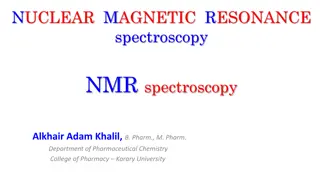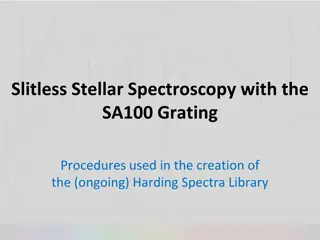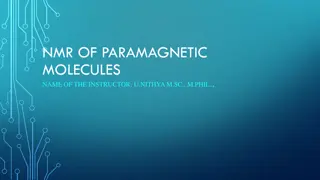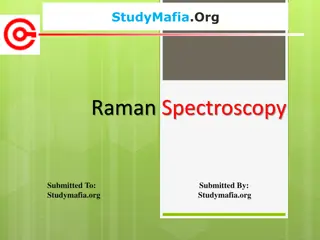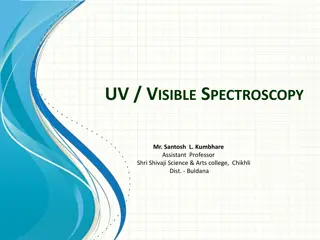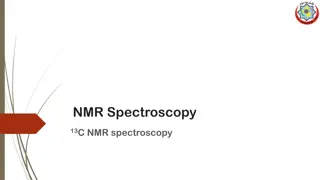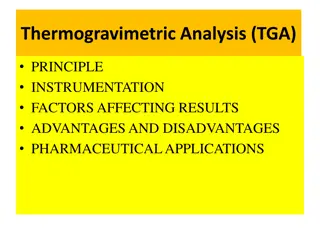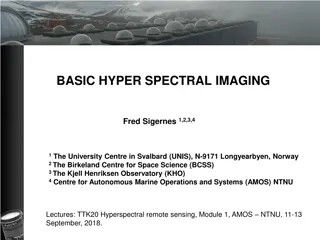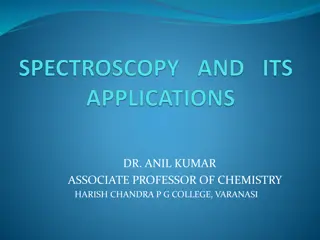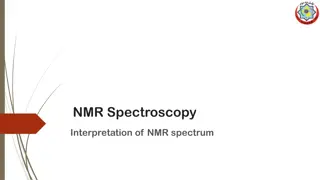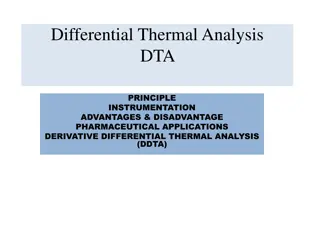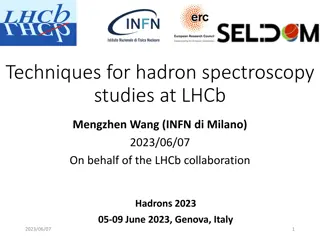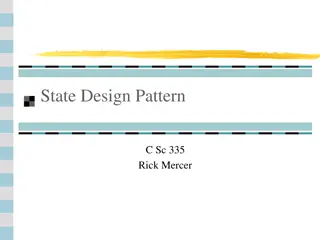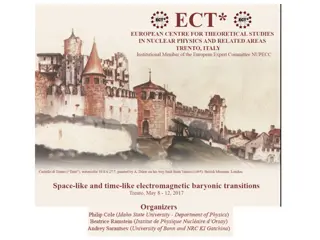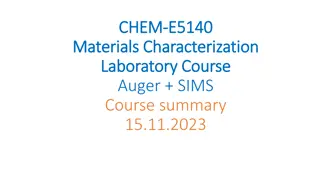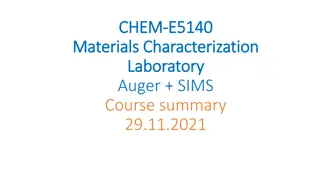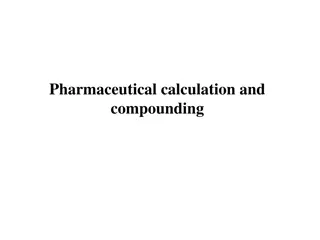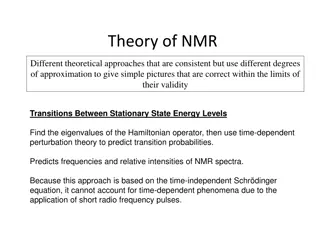Spectroscopy and Pattern Recognition in Pharmaceutical Analysis
Understanding spectroscopy and pattern recognition in pharmaceutical analysis is crucial for interpreting 1H NMR spectra. Specific splitting patterns indicate the presence of various functional groups like ethyl, isopropyl, and tert-butyl. Recognizing these patterns aids in identifying compounds efficiently. Complex splitting can occur when a proton has different neighboring protons. Utilize pattern recognition as a key tool in NMR spectrum analysis for accurate compound structural elucidation.
Download Presentation

Please find below an Image/Link to download the presentation.
The content on the website is provided AS IS for your information and personal use only. It may not be sold, licensed, or shared on other websites without obtaining consent from the author. Download presentation by click this link. If you encounter any issues during the download, it is possible that the publisher has removed the file from their server.
E N D
Presentation Transcript
Advanced Pharmaceutical Analysis Introduction to Spectroscopy Dr. Mohammed Al Amiedy
Pattern Recognition Specific splitting patterns are commonly seen in 1H NMR spectra, and recognizing these patterns allows for a more efficient analysis. The figure below shows the characteristic splitting pattern of an isolated ethyl group (isolated means that the CH2protons are only being split by the CH3protons). A compound containing an isolated ethyl group will display a triplet with an integration of 3, upfield from a quartet with an integration of 2 in its 1H NMR spectrum.
Pattern Recognition The presence of these signals in a spectrum is strongly suggestive of the presence of an ethyl group in the structure of the compound. Since the two kinds of protons of an ethyl group are splitting each other, the J values for the triplet and quartet must be equivalent. Another commonly observed splitting pattern is produced by isopropyl groups. A compound containing an isolated isopropyl group will display a doublet with an integration of 6, upfield from a septet (seven peaks) with an integration of 1.
Pattern Recognition The presence of these signals in a 1H NMR spectrum is strongly suggestive of the presence of an isopropyl group in the structure of the compound. A septet is usually hard to see, since it is so small (integration of 1), so an enlarged reproduction (inset) of the signal is often displayed above the original signal. Another commonly observed pattern is produced by tert-butyl groups A compound containing a tert-butyl group will display a singlet with a relative integration of 9.
Pattern Recognition The presence of this signal in a 1H NMR spectrum is strongly suggestive of the presence of a tert-butyl group in the structure of the compound. Pattern recognition is an important tool when analyzing NMR spectra, so let s quickly review the patterns we have seen
Complex splitting Complex splitting occurs when a proton has two different kinds of neighboring protons. For example: Consider the expected splitting pattern for Hb in this example. The signal for Hb is being split into a quartet because of the nearby Ha protons, and it is being split into a triplet because of the nearby Hc protons.
Complex splitting The signal will therefore be comprised of 12 peaks (4 3). The appearance of the signal will depend greatly on the J values. If Jab is much greater than Jbc , then the signal will appear as a quartet of triplets. If, however, Jbc is much greater than Jab, then the signal will appear as a triplet of quartets. In most cases, the J values will be fairly similar, and we will observe neither a cleanquartet of triplets nor a clean triplet of quartets.
Complex splitting In some cases, Jab and Jac will be almost identical. For example, the 1H NMR spectrum of 1-nitropropane Look carefully at the splitting pattern of the Hb protons (at approximately 2 ppm). This signal looks like a sextet, because Jab and Jbc are so close in value. In such a case, it appears as if there are five equivalent neighbors, even though all five protons are not equivalent.
Protons That Lack Observable Coupling Constants We have seen that some protons can produce signals that exhibit complex splitting. In contrast, we will now explore cases in which a proton can produce a signal for which splitting is not observed despite the presence of neighboring protons. Consider the following 1H NMR spectrum of ethanol. As expected, the spectrum exhibits the characteristic signals of an ethyl group. In addition, another signal is observed at 2.2 ppm, representing the hydroxyl proton (OH).
Protons That Lack Observable Coupling Constants Hydroxyl protons typically produce a signal between 2 and 5 ppm, and it is often difficult to predict exactly where that signal will appear.
Protons That Lack Observable Coupling Constants In this NMR spectrum, notice that the hydroxyl proton is not split into a triplet from the neighboring methylene group. Generally, no splitting is observed across the oxygen atom of an alcohol, because proton exchange is a very rapid process that is catalyzed by trace amounts of acid or base. Hydroxyl protons are said to be labile, because of the rapid rate at which they are exchanged.
Protons That Lack Observable Coupling Constants This proton transfer process occurs at a faster rate than the timescale of an NMR spectrometer, producing a blurring effect that averages out any possible splitting effect. It is possible to slow down the rate of proton transfer by fully removing the trace amounts of acid and base dissolved in ethanol. Such purified ethanol does in fact exhibit splitting across the oxygen atom, and the signal at 2.2 ppm is observed to be a triplet.
Protons That Lack Observable Coupling Constants There is one other common example of neighboring protons that often do not produce observable splitting. Aldehydic protons, which generally produce signals near 10 ppm, will often couple only weakly with their neighbors (i.e., a very small J value). Depending on the size of the J value, splitting may or may not be noticeable. If the J value is too small, then the signal near 10 ppm will appear to be a singlet, despite the presence of neighboring protons.
Analyzing a 1H NMR Spectrum Always begin by inspecting the molecular formula (if it is given), as it provides useful information. Specifically, calculating the hydrogen deficiency index (HDI) can provide important clues about the structure of the compound. An HDI of zero indicates that the compound does not possess any rings or bonds. An HDI of 1 indicates that the compound has either one ring or one bond. The larger the HDI, the less useful it is. An HDI of 4 or more should indicate the possible presence of an aromatic ring.
Analyzing a 1H NMR Spectrum Consider the number of signals and integration of each signal (gives clues about the symmetry of the compound). Analyze each signal (chemical shift, integration, and multiplicity) and then draw fragments consistent with each signal. These fragments become our puzzle pieces that must be assembled to produce a molecular structure. Assemble the fragments into a molecular structure. Verify that the proposed structure is consistent with all of the spectral data.
Analyzing a 1H NMR Spectrum Identify the structure of a compound with the molecular formula C9H10O that exhibits the following 1H NMR spectrum:
Analyzing a 1H NMR Spectrum Begin by calculating the HDI. The molecular formula indicates 9 carbon atoms, which would require 20 hydrogen atoms in order to be fully saturated. There are only 10 hydrogen atoms, which means that 10 hydrogen atoms are missing, and therefore, the HDI is 5. This is a large number, and it would not be efficient to think about all the possible ways to have five degrees of unsaturation. However, anytime we encounter an HDI of 4 or more, we should be on the lookout for an aromatic ring
Analyzing a 1H NMR Spectrum We must keep this in mind when analyzing the spectrum. In this case, we should expect to see an aromatic ring (HDI = 4) plus one other degree of unsaturation (either a ring or a double bond). Next, consider the number of signals and the integration value for each signal. Be on the lookout for integration values that would suggest the presence of symmetry elements. For example, a signal with an integration of 4 would suggest two equivalent CH2groups.
Analyzing a 1H NMR Spectrum In this spectrum, we see four signals. In order to analyze the integration of each signal, we must first divide by the lowest number (10.2): The ratio is approximately 1 : 5 : 2 : 2. Now look at the molecular formula. There are 10 protons in the compound, so the relative integration values represent the actual number of protons giving rise to each signal.
Analyzing a 1H NMR Spectrum Now analyze each signal. Starting upfield, there are two triplets, each with an integration of 2. This suggests that there are two adjacent methylene groups.
Analyzing a 1H NMR Spectrum These signals do not appear at 1.2, where methylene groups are expected, so one or more factors are shifting these signals downfield. Our proposed structure must take this into account. Moving downfield through the spectrum, the next signal appears just above 7 ppm, characteristic of aromatic protons (just as we suspected after analyzing the HDI). More often, a multiplet of overlapping signals is observed. But the integration value gives valuable information.
Analyzing a 1H NMR Spectrum Specifically, there are five aromatic protons, which means that the aromatic ring is monosubstituted. Next, move on to the last signal, which is a singlet at 10 ppm with an integration of 1. This is suggestive of an aldehydic proton. Our analysis has produced the following fragments:
Analyzing a 1H NMR Spectrum Now assemble these fragments. Fortunately, there is only one way to assemble these three puzzle pieces.
Analyzing a 1H NMR Spectrum As a final check, let s make sure that our proposed structure is consistent with all spectral data. The structure has a monosubstituted aromatic ring (it has five aromatic protons), consistent with a multiplet that has an integration of 5H appearing between 7 and 8 ppm. The aldehyde proton is consistent with a singlet at 10 ppm with an integration of 1H. Finally, there are two different methylene groups that are coupled to each other, so each is split into a triplet.
Analyzing a 1H NMR Spectrum Each of these triplets is shifted downfield (relative to the benchmark value of 1.2 ppm for a methylene group) as a result of one or more factors. In particular, one methylene group is shifted significantly by the carbonyl group and slightly by the aromatic ring. The other methylene group is being shifted significantly by the aromatic ring and slightly by the carbonyl group. Therefore, our proposed structure is consistent with all of the spectral data.
Noradrenaline (also called norepinephrine) and serotonin are neurotransmitters that act in the central nervous system. A synthetic compound called PMPEA has effects that are similar to both noradrenaline and serotonin in the spinal cord. Deduce the structure of PMPEA, given its molecular formula (C9H13NO) and the following 1H NMR spectral data: 1.1 (2H, broad singlet) 2.9 (2H, triplet) 6.8 (2H, doublet) 2.7 (2H, triplet) 3.8 (3H, singlet) 7.1 (2H, doublet)
Acquiring a 13C NMR Spectrum Many of the principles that apply to 1H NMR spectroscopy also apply to 13C NMR spectroscopy, but there are a few major differences, and we will focus on those. For example, 1H is the most abundant isotope of hydrogen, but 13C is only a minor isotope of carbon, representing about 1.1% of all carbon atoms found in nature. As a result, only one in every hundred carbon atoms will resonate, which demands the use of a sensitive receiver coil for 13C NMR spectroscopy.
Acquiring a 13C NMR Spectrum In 1H NMR spectroscopy, we saw that each signal has three characteristics (chemical shift, integration, and multiplicity). In 13C NMR spectroscopy, only the chemical shift is generally reported. The integration and multiplicity of 13C signals are not reported, which greatly simplifies the interpretation of 13C NMR spectra. Integration values are not routinely calculated in 13C NMR spectroscopy because the pulse technique employed by FTNMR spectrometers has the undesired effect of distorting the integration values. Multiplicity is not a common feature of 13C NMR spectra.
Acquiring a 13C NMR Spectrum Notice that all of the signals are recorded as singlets. There are several good reasons for this. First, no splitting is observed between neighboring carbon atoms because of the low abundance of 13C. The likelihood of a compound having two neighboring 13C atoms is quite small, so 13C 13C splitting is not observed.
Acquiring a 13C NMR Spectrum In contrast, 13C 1H splitting does occur, and it creates significant problems. The signal of each 13C atom nucleus is split not only by the protons directly connected to it (separated by only one sigma bond) but also by the protons that are two or three sigma bonds removed. This leads to very complex splitting patterns, and signals overlap to produce an unreadable spectrum. To solve the problem, all 13C 1H splitting is suppressed with a technique called broadband decoupling, which uses two rf transmitters.
Acquiring a 13C NMR Spectrum The first transmitter provides brief pulses in the range of frequencies that cause 13C nuclei to resonate, while the second transmitter continuously irradiates the sample with the range of frequencies that cause all 1H nuclei to resonate. This second rf source effectively decouples the 1H nuclei from the 13C nuclei, causing all of the 13C signals to collapse to singlets. The advantage of broadband decoupling comes at the expense of useful information that would otherwise be obtained from spin-spin coupling.
Acquiring a 13C NMR Spectrum A technique called off-resonance decoupling allows us to retrieve some of this information. With this technique, only the one-bond couplings are observed, so CH3groups appear as quartets, CH2groups appear as triplets, CH groups appear as doublets, and quaternary carbon atoms appear as singlets. Nonetheless, off-resonance decoupling is rarely used because it often produces overlapping peaks that are difficult to interpret.
Chemical Shifts in 13C NMR Spectroscopy The range of rf frequencies in 13C spectroscopy is different from that used in 1H NMR spectroscopy, because 13C atoms resonate over a different frequency range. Just as in 1H NMR spectroscopy, the position of each signal is defined relative to the frequency of absorption of a reference compound, TMS. The chemical shift of each 13C atom is constant, regardless of the operating frequency of the spectrometer. In 13C NMR spectroscopy, chemical shift values typically range from 0 to 220 ppm
Chemical Shifts in 13C NMR Spectroscopy The number of signals in a 13C NMR spectrum represents the number of carbon atoms in different electronic environments (not interchangeable by symmetry). Carbon atoms that are interchangeable by a symmetry operation (either rotation or reflection) will only produce one signal. Consider the following compounds. Each compound has eight carbon atoms but does not produce eight signals. The unique carbon atoms in each compound are highlighted. Each carbon atom that is not highlighted is equivalent to one of the highlighted carbon atoms.
Chemical Shifts in 13C NMR Spectroscopy The location of each signal is dependent on shielding and deshielding effects, just as we saw in 1H NMR spectroscopy
Chemical Shifts in 13C NMR Spectroscopy Consider the following compound: Predict the number of signals and the location of each signal in a 13C NMR spectrum of this compound.
Chemical Shifts in 13C NMR Spectroscopy Begin by determining the number of expected signals. The compound has nine carbon atoms, but we must look to see if any of these carbon atoms are interchangeable by a symmetry operation. In this case, there is both a plane and an axis of symmetry. As a result, we expect only five signals in the 13C NMR spectrum.
Chemical Shifts in 13C NMR Spectroscopy In general, when two methyl groups are attached to the same carbon atom, they will be equivalent. This is not the case in this example, because one methyl group is cis to the carbonyl (C=O) group, while the other methyl group is trans to the carbonyl group. The expected chemical shifts are shown below, categorized according to the region of the spectrum in which each signal is expected to appear:
DEPT 13C NMR Spectroscopy A broadband-decoupled 13C spectrum does not provide information regarding the number of protons attached to each carbon atom in a compound. This information can be obtained through a variety of recently developed techniques, one of which is called distortionless enhancement by polarization transfer (DEPT). DEPT 13C NMR spectroscopy utilizes two rf transmitters and relies on the fact that the intensity of each particular signal will respond to different pulse sequences in a predictable fashion, depending on the number of protons attached.
DEPT 13C NMR Spectroscopy This technique involves the acquisition of several spectra. First, a regular broadband-decoupled 13C spectrum is acquired, indicating the chemical shifts associated with all carbon atoms in the compound. Then a special pulse sequence is utilized to produce a spectrum called a DEPT-90, in which only signals from CH groups appear. This spectrum does not show any signals resulting from CH3 groups, CH2groups, or quaternary carbon atoms (C with no protons).
DEPT 13C NMR Spectroscopy Then, a different pulse sequence is employed to generate a spectrum, called a DEPT-135, in which CH3groups and CH groups appear as positive signals, CH2groups appear as negative signals (pointing down), and quaternary carbon atoms do not appear. By comparing all of the spectra, it is possible to identify each signal in the broadband-decoupled spectrum as arising from either a CH3group, a CH2group, a CH group, or a quaternary carbon atom. This information is summarized in table below.

 undefined
undefined

